AUDI TT ROADSTER 2014 Repair Manual
Manufacturer: AUDI, Model Year: 2014, Model line: TT ROADSTER, Model: AUDI TT ROADSTER 2014Pages: 244, PDF Size: 60.87 MB
Page 61 of 244
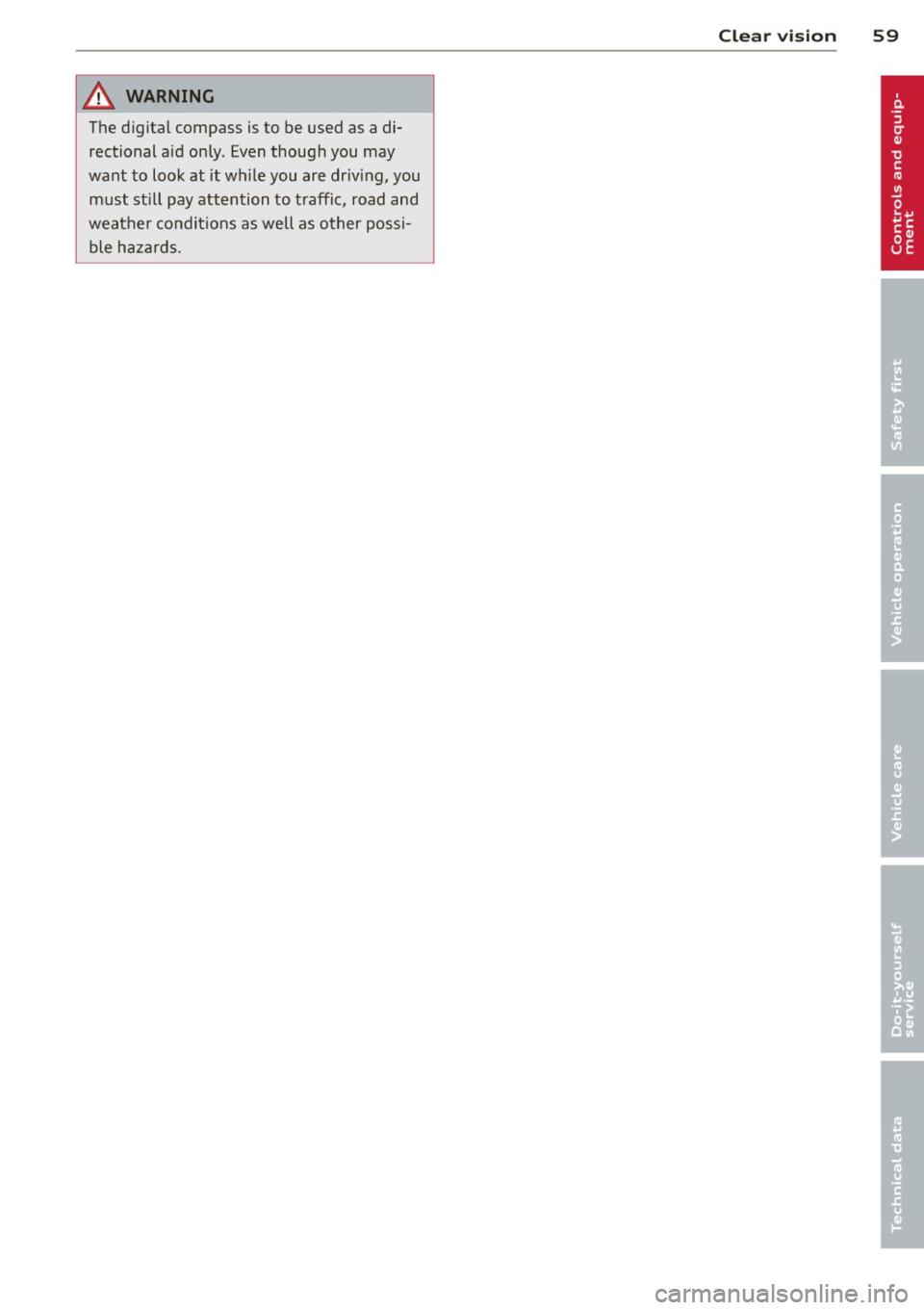
A WARNING ,~
The d igital compass is to be used as a di
rectional a id only. Even though you may
want to look at it wh ile you are driv ing, you
must still pay att ention to t raffic, road and
weather co ndit ions as well as o ther possi
ble h azards.
Clear vis ion 59
Page 62 of 244
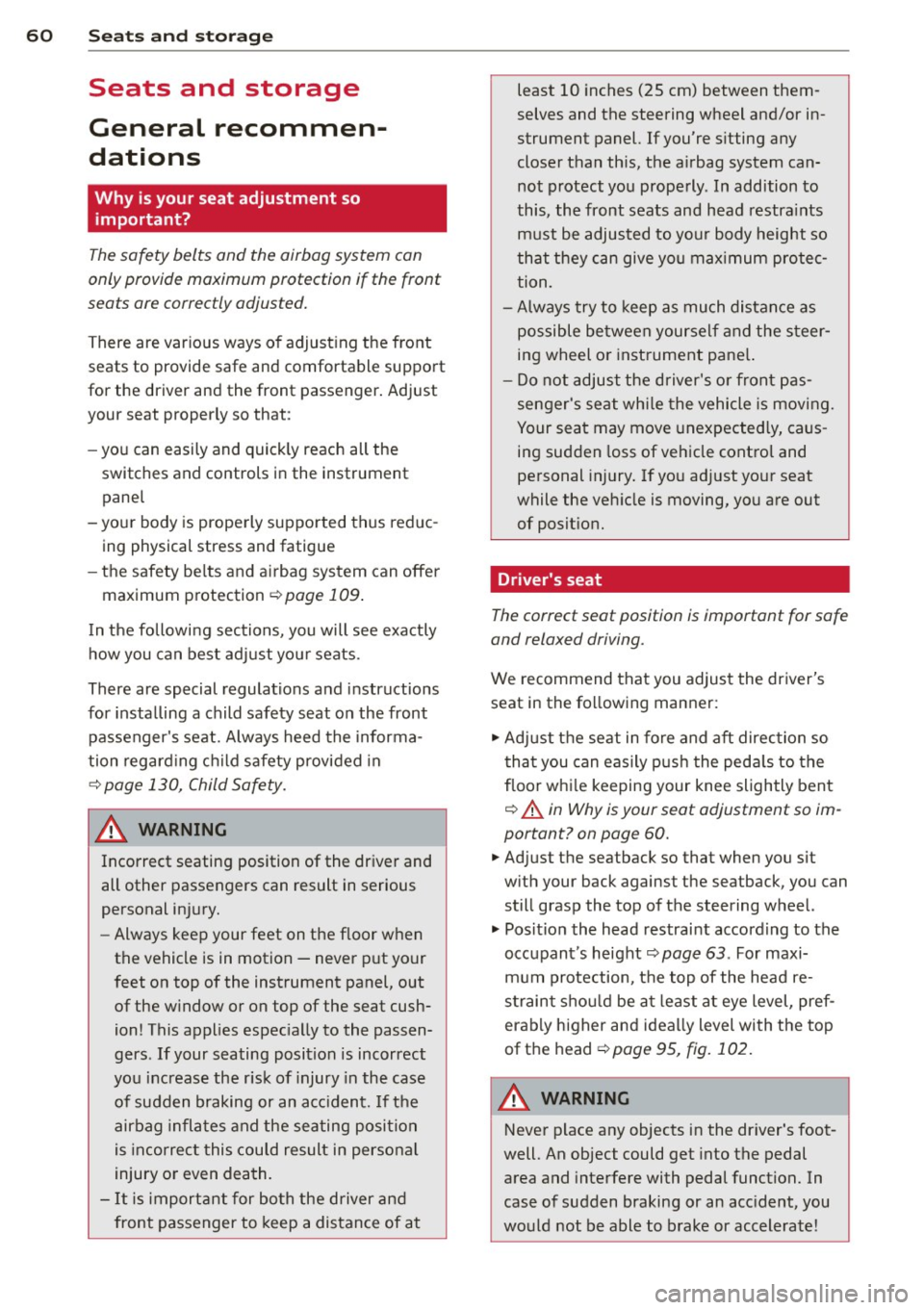
60 Seats and stor age
Seats and storage
General recommen
dations
Why is your seat adjustment so
important?
The safety belts and the airbag system can
only provide maximum protection if the front
seats are correctly adjusted.
There are various ways of adjusting the front
seats to provide safe and comfortable support
for the driver and the front passenger. Adjust
you r seat prope rly so that :
- you can easily and quickly reach all the
switches and controls in the instrument
panel
-your body is properly supported thus reduc
ing physical stress and fatigue
- the safety be lts and airbag system can offer
maximum protection
¢ page 109.
In the following sections, you will see exactly
how you can best adjust your seats .
There are special regulations and instructions
for installing a child safety seat on the front
passenger's seat. Always heed the informa
tion regarding child safety provided in
¢ page 130, Child Safety.
A WARNING
Incorrect seating position of the driver and
all other passengers can result in serious
personal injury.
- Always keep your feet on the floor when
the vehicle is in motion -never put your
feet on top of the instrument panel, out
of the window or on top of the seat cush
ion! This applies especially to the passen
gers .
If your seating position is incorrect
you increase the risk of injury in the case
of sudden braking or an acc ident.
If the
airbag inflates and the seating position
is incorrect this could result in personal
injury or even death.
- It is important for both the driver and
front passenger to keep a distance of at least 10
inches (25 cm) between them
selves and the steering wheel and/or in
strument panel. If you're sitting any
closer than this, the airbag system can not protect you properly . In addition to
this, the front seats and head restraints
must be adjusted to your body height so
that they can give you maximum protec
tion.
- Always try to keep as much distance as
possible between yourself and the steer
ing wheel or instrument panel.
- Do not adjust the driver's or front pas
senger's seat whi le the vehicle is moving.
Your seat may move unexpectedly, caus
ing sudden loss of vehicle control and
personal injury. If you adjust your seat
while the vehicle is moving, you are out of position.
Driver's seat
The correct seat position is important for safe
and relaxed driving.
We recommend that you adjust the driver's
seat in the following manner :
.,. Adjust the seat in fore and aft direction so
that you can easily push the peda ls to the
floor whi le keeping your knee slightly bent
i::> A in Why is your seat adjustment so im
portant? on page 60 .
.,. Adjust the seatback so that when you sit
with your back against the seatback , you can
still grasp the top of the steering wheel.
.,. Position the head restraint according to the
occupant 's height
<=:> page 63 . For maxi
mum protection, the top of the head re
straint shou ld be at least at eye level, pref
erably higher and ideally level with the top
of the head
¢ page 95, fig. 102.
A WARNING "--
Never place any objects in the driver's foot-
well. An object could get into the pedal
area and interfere with pedal function. In
case of sudden braking or an accident, you
would not be able to brake or accelerate!
Page 63 of 244
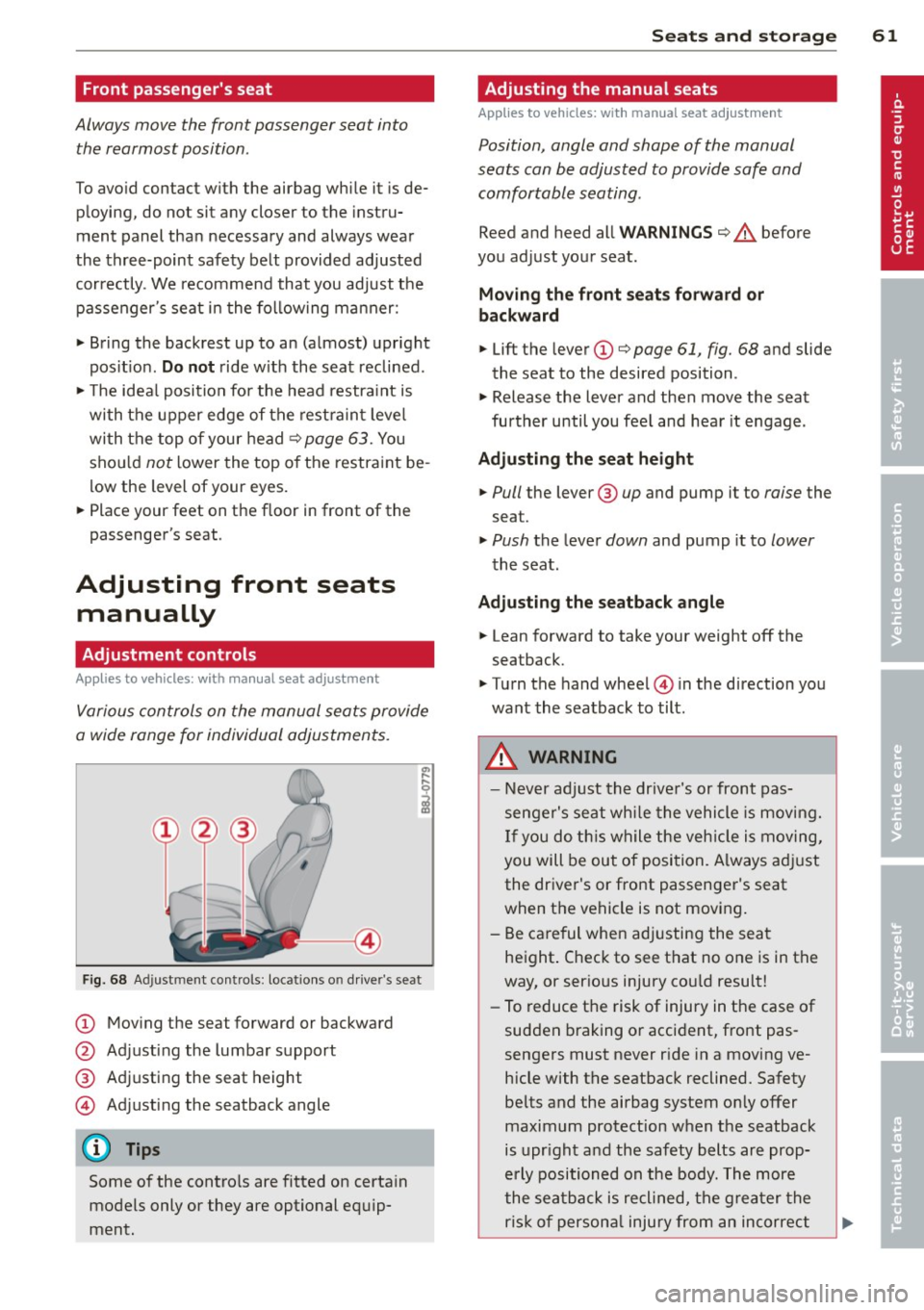
Front passenger's seat
Always move the front passenger seat into the rearmost position .
To avoid contact with the airbag while it is de
p loying, do not sit any closer to the instru
ment panel than necessary and always wear
the three-point safety belt provided adjusted
correctly . We recommend that you adjust the
passenger's seat in the following manner:
"' Bring the backrest up to an (almost) upright
pos it ion.
Do not ride with the seat reclined.
"'T he idea l position for the head restraint is
with the upper edge of the restraint level
with the top of your head
Q page 63. You
shou ld
not lower the top of the restraint be
low the level of your eyes.
"' Place your feet on the f loor in front of the
passenger's seat .
Adjusting front seats
manually
Adjustment controls
Applies to vehicles: with manual seat adjustment
Various controls on the manual seats provide
a wide range for individual adjustments.
Fig. 68 Ad just ment contro ls : locat ions o n drive r's seat
(!) Moving the seat forward or backward
@ Adjusting the lumbar support
® Adjusting the seat height
© Adjusting the seatback angle
{!) Tips
Some of the contro ls are fitted on certain
models only or they are optional equip
ment.
Seats and storage 61
Adjusting the manual seats
Applies to vehicles: with manual seat adjustment
Position, angle and shape of the manual
seats can be adjusted to provide safe and
comfortable seating .
Reed and heed all WARNINGS ¢..&. before
you adjust your seat.
Moving the front seats forward or
backward
"' Lift the lever (!)¢ page 61, fig. 68 and slide
the seat to the desired position .
"' Release the lever and then move the seat
further until you fee l and hear it engage .
Adjusting the seat height
"' Pull the lever ® up and pump it to raise the
seat.
"' Push the lever down and pump it to lower
the seat .
Adjusting the seatback angle
"' Lean forward to take your weight off the
seatback.
"' Turn the hand wheel © in the direction you
want the seatback to tilt .
A WARNING -
-Never adjust the driver's or front pas
senger's seat while the vehicle is moving.
If you do this while the vehicle is moving,
you will be out of position. A lways adjust
the driver's or front passenger's seat
when the vehicle is not moving.
- Be careful when adjusting the seat
height . Check to see that no one is in the
way, or ser ious injury cou ld result!
- To reduce the risk of injury in the case of
sudden braking or accident, front pas
sengers must never ride in a moving ve
hicle with the seatback reclined. Safety
be lts and the airbag system only offer
maximum protection when the seatback
is upr ight and the safety belts are prop
erly positioned on the body. The more
the seatback is reclined, the greater the
risk of persona l injury from an incorrect
Page 64 of 244
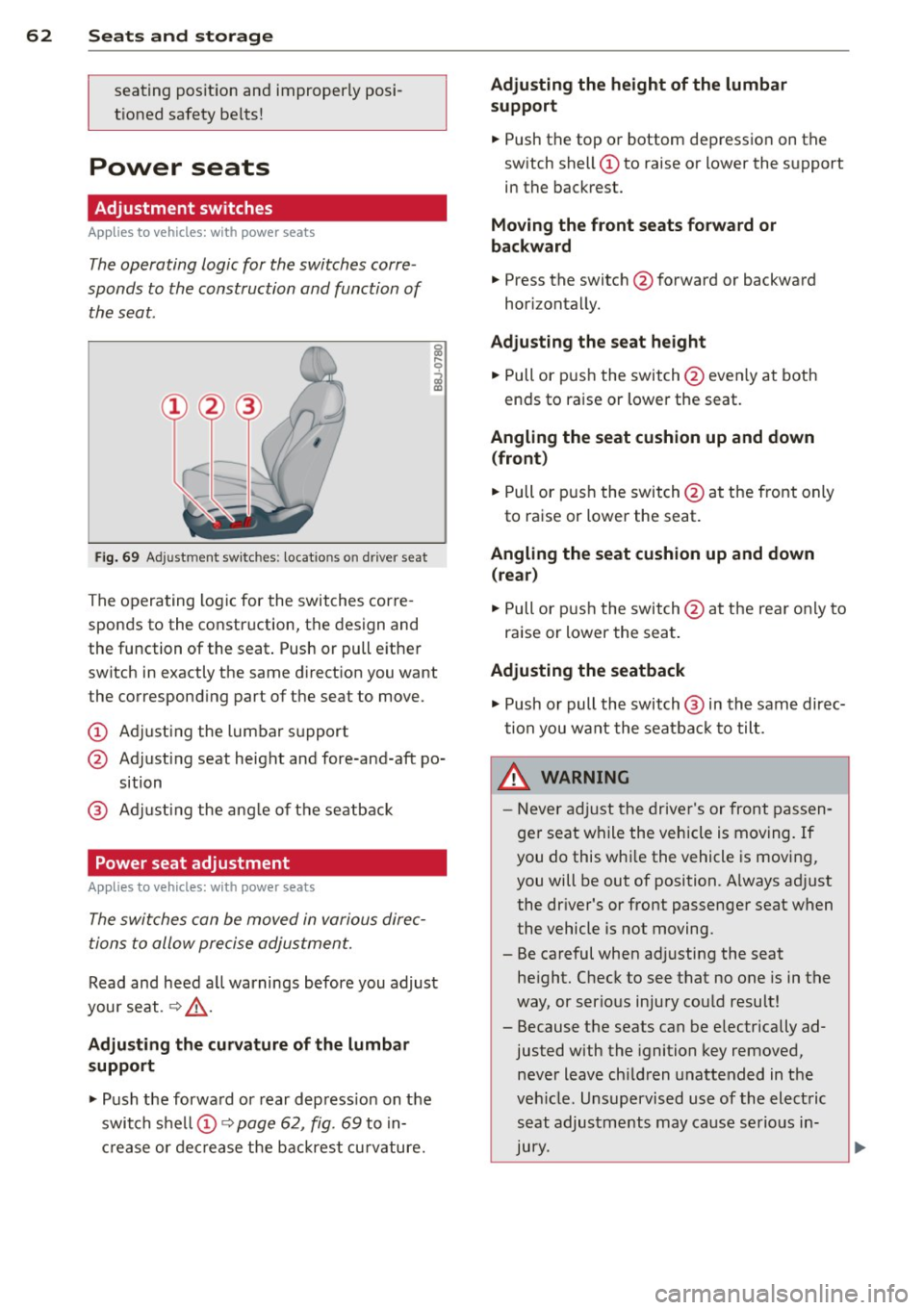
62 Seats and storage
seating position and improperly posi
tioned safety be lts!
Power seats
Adjustment switches
App lies to vehicles: wit h power seats
The operating logic for the switches corre
sponds to the construction and function of
the seat.
Fig. 69 Adjustment switches: locations on driver seat
The operating logic for the switches corre
sponds to the construction, the design and
the function of the seat. Push or pull either
switch in exactly the same direction you want
the corresponding part of the seat to move.
CD Adjusting the lumbar support
@ Adjusting seat height and fore-and-aft po
sition
@ Adjusting the angle of the seatback
Power seat adjustment
Applies to vehicles: with power seats
The switches can be moved in various direc
tions to allow precise adjustment.
Read and heed all warnings before you adjust
your seat. ¢&_ .
Adjusting the curvature of the lumbar
support
.,. Push the forward or rear depress ion on the
switch shell CD¢
page 62, fig. 69 to in
crease or decrease the backrest curvature.
Adjusting the height of the lumbar
support
.,. Push the top or bottom depression on the
switch shell CD to raise or lower the support
in the backrest.
Moving the front seats forward or
backward
.,. Press the switch @forward or backward
horizontally.
Adjusting the seat height
.,. Pull or push the switch @even ly at both
ends to raise or lower the seat.
Angling the seat cushion up and down (front )
.,. Pull or push the switch @at the front only
to raise or lower the seat.
Angling the seat cushion up and down (rear)
.,. Pull or push the switch@at the rear only to
raise or lower the seat .
Adjusting the seatback
.,. Push or pull the switch @ in the same direc
tion you want the seatback to tilt.
,&. WARNING
-Never adjust the driver's or front passen
ger seat while the vehicle is moving.
If
you do this while the vehicle is moving,
you will be out of position. A lways ad just
the dr iver's or front passenger seat when
the vehicle is not moving.
- Be careful when adj usting the seat
height. Check to see that no one is in the
way, or serious injury could result!
- Because the seats can be e lectrically ad
justed with the ignition key removed,
never leave ch ildren unattended in the
vehicle. Unsupervised use of the electric
seat adjustments may cause serious in
Jury.
Page 65 of 244
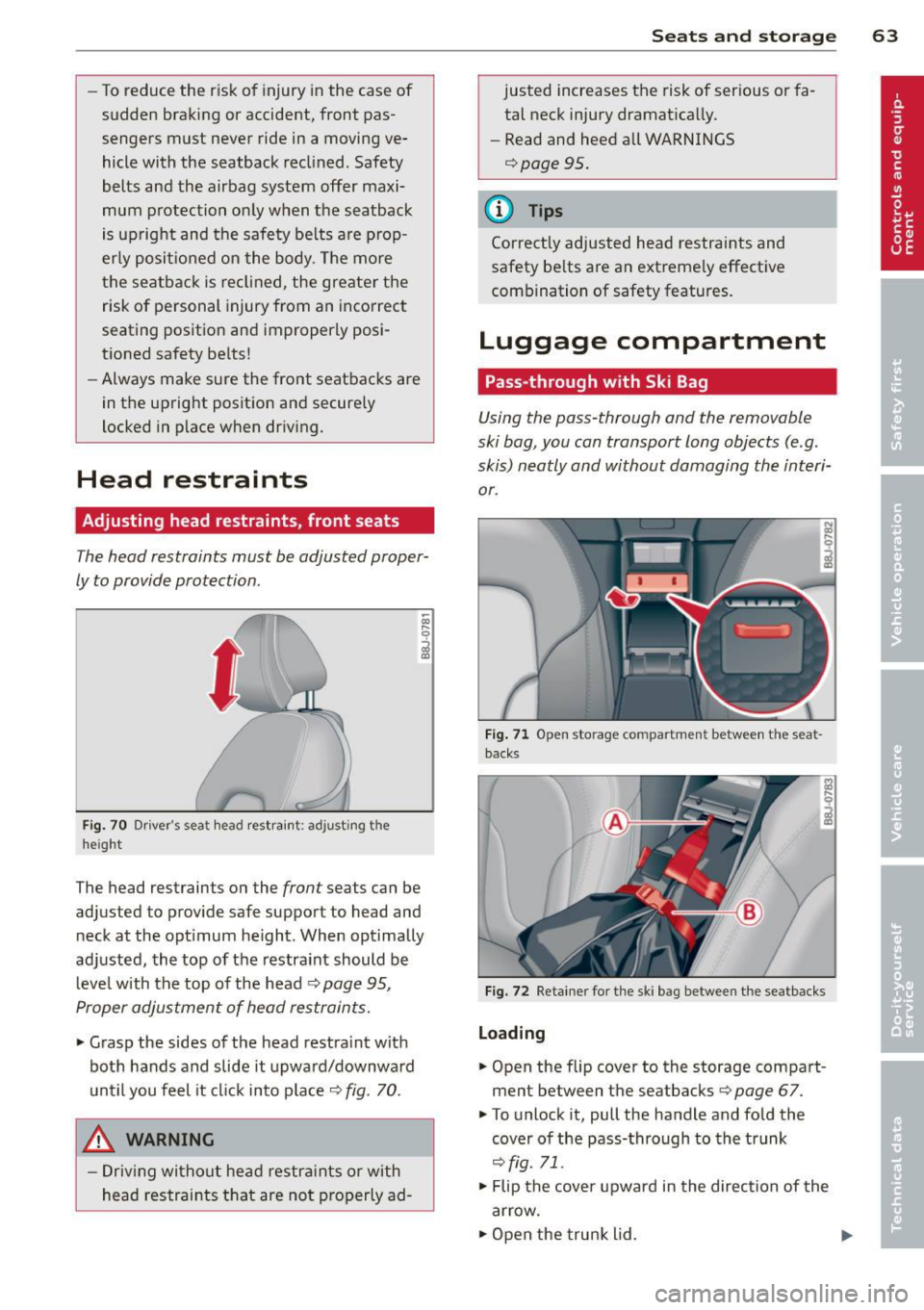
-To reduce the risk of injury in the case of
sudden braking or accident, front pas
sengers must never ride in a moving ve
hicle with the seatback reclined. Safety
belts and the airbag system offer maxi
mum protection only when the seatback
is upright and the safety be lts are prop
erly positioned on the body. The more
the seatback is reclined, the greater the
risk of personal injury from an incorrect
seating position and improperly posi
tioned safety be lts!
- Always make sure the front seatbacks are
in the upright position and securely
locked in place when dr iving.
Head restraints
Adjusting head restraints, front seats
The head restraints must be adjusted proper
ly to provide protection .
Fig. 70 Dr iver 's seat head restraint: ad just ing t he
height
The head restraints on the front seats can be
adjusted to provide safe support to head and neck at the opt imum he ight. When optimally
adjusted, the top of the restraint should be
level with the top of the head ¢
page 95,
Proper adjustment of head restraints.
... Grasp the sides of the head restraint with
both hands and slide it upward/downward
until you feel it click into place¢
fig. 70.
_& WARNING
- Driving without head restraints or with
head restraints that are not properly ad-
-
Seats and storage 63
justed increases the risk of serious or fa
tal neck injury dramat ica lly.
- Read and heed all WARNINGS
¢page 95.
(D Tips
Correctly adjusted head restraints and
safety be lts are an extreme ly effective
combination of safety features.
Luggage compartment
Pass-through with Ski Bag
Using the pass-through and the removable
ski bag, you can transport long objects (e .g.
skis) neatly and without damaging the interi
or.
Fig. 71 Open storage co mpartmen t between th e seat
backs
Fig. 72 Retainer fo r the ski bag between the seatbacks
Loading
... Open the flip cover to the storage compart
ment between the seatbacks ¢
page 67 .
... To unlock it, pull the handle and fold the
cover of the pass-through to the trunk
<=> fig. 71.
"'"Flip the cover upward in the direction of the
arrow.
"'" Open the trunk lid .
Page 66 of 244
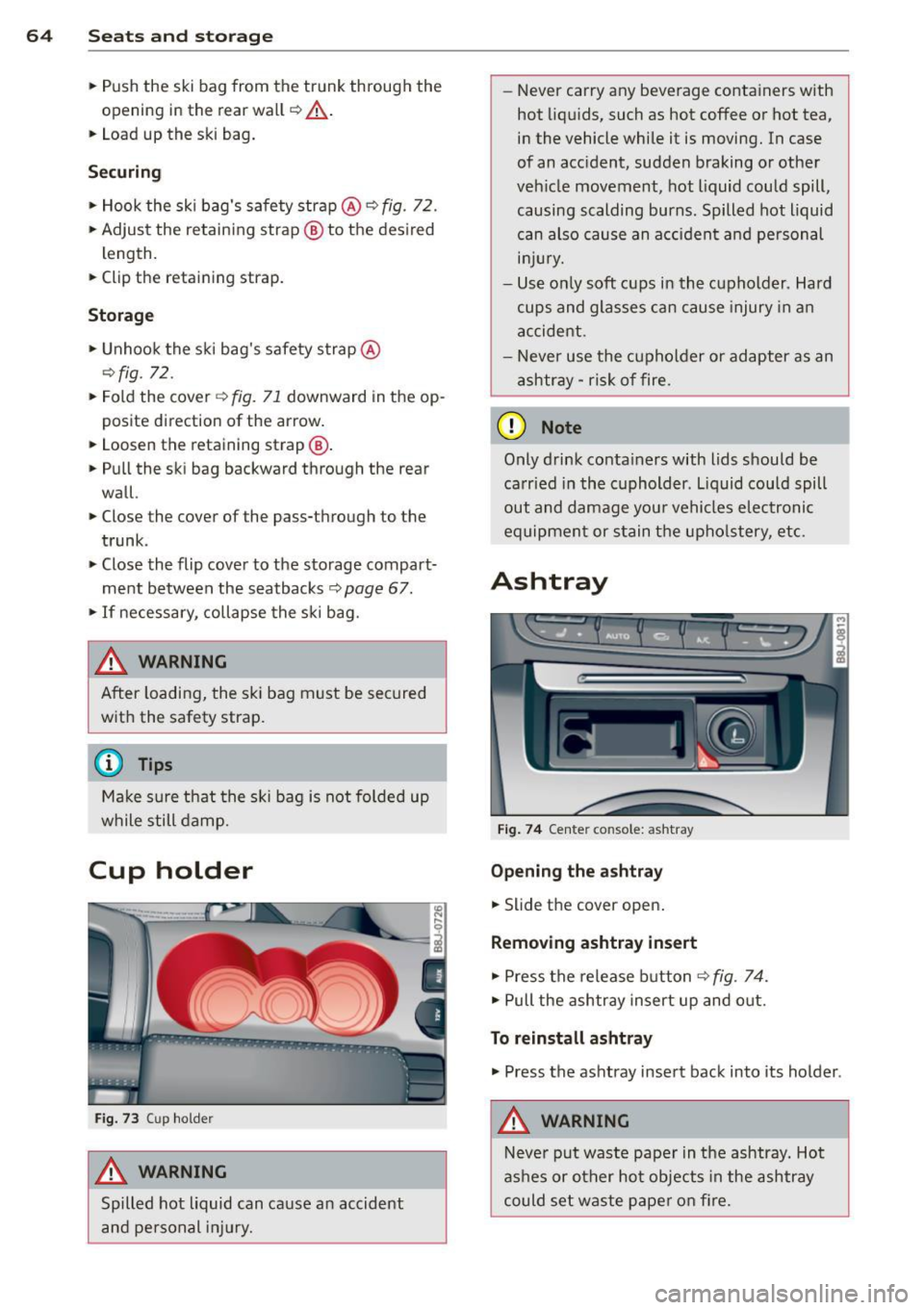
64 Seats and storage
• Push the ski bag from the trunk through the
opening in the rear wall
c::> &_.
• Load up the ski bag.
Securing
• Hook the ski bag 's safety strap @ c::> fig. 72.
• Adjust the retain ing strap @ to the des ired
length .
• Clip the retaining strap.
Storag e
• Unhoo k the ski bag's safety strap @
¢fig. 72.
• Fold the cover¢
fig. 71 downward in the op
posite direction of the arrow .
• Loosen the retaining strap@.
• Pull the ski bag backward through the rear
wall.
• Close the cover of the pass-through to the
trunk .
• Close the flip cove r to the storage compart
ment between the seatbacks ¢
page 67.
• If necessary, collapse the s ki bag.
_& WARNING
After loading, the sk i bag must be secured
w ith the safety strap.
(D Tips
Ma ke sure that the s ki bag is not folded up
while still damp.
Cup holder
F ig. 73 Cup holder
_& WARNING ,. -
Spilled hot liquid can cause an accident
and pe rsonal injury. -
Never carry any beverage conta iners with
hot liqu ids, such as hot coffee or hot tea,
in the vehicle while it is moving. In case
of an acc ident, sudden braking or other
veh icle movement, hot liquid could spill,
causing scalding burns . Spilled hot liquid
can also cause an accident and pe rsonal
inju ry.
- Us e only soft cups in the c upholder. Hard
cups and glasses can cause injury in an
accident.
- Neve r use the cupholder or adapter as an
ashtray -ris k of fire.
(1) Note
Only drink containers with Lids should be
carried in the cuphold er. L iquid could spill
out and damage your vehicles electronic
equipmen t or s tain t he upho lstery, etc.
Ashtray
Fig . 7 4 Center console: ashtray
Opening the ashtray
• Slide the cover open.
Removing ashtray insert
• Press the release button ¢fig . 74.
• Pull the ashtray insert up and out.
To r einstall a shtray
• Press the ashtray insert back into its holder.
_& WARNING
-Never put waste paper in the ashtray. Hot
as hes or other hot objects in the ashtray
could set waste paper on fire.
Page 67 of 244
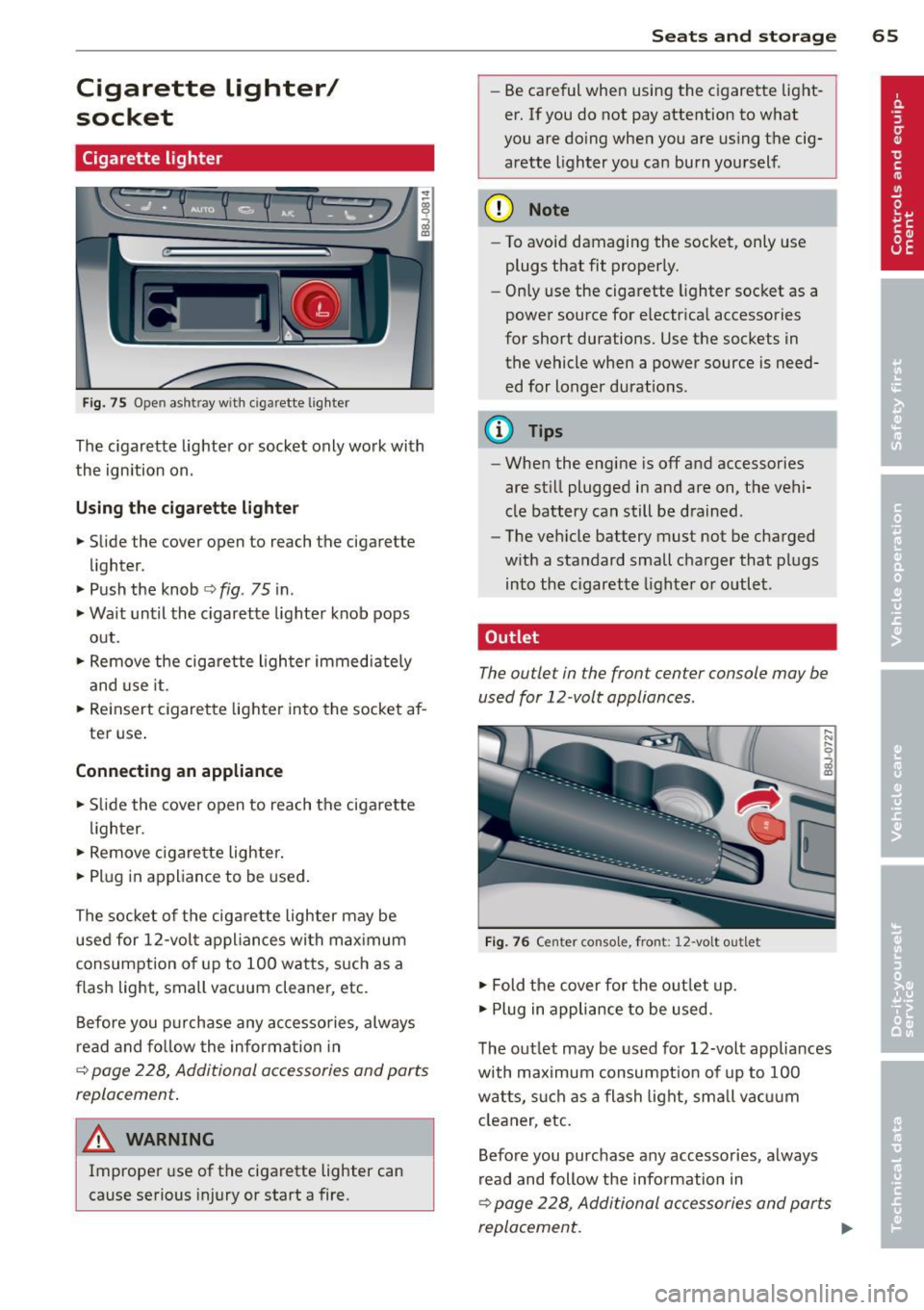
Cigarette lighter/
socket
Cigarette lighter
Fig. 75 Open ashtray with cigar ette ligh ter
The cigarette lighter or socket only work with
the ignition on.
Using the cigarette lighter
.,. Slide the cover open to reach the cigarette
lighter.
.,. Push the knob¢
fig. 75 in .
.,. Wait until the cigarette lighter knob pops
out .
.,. Remove the cigarette lighter immediately
and use it.
.,. Reinsert cigarette lighter into the socket af
ter use.
Connecting an appliance
.,. Slide the cover open to reach the cigarette
lighter.
.,. Remove cigarette lighter .
.,. Plug in appliance to be used.
The socket of the cigarette lighter may be used for 12-volt appliances with maximum
consumption of up to 100 watts, such as a
f lash Light, small vacuum cleaner, etc.
Before you purchase any accessories, always
read and follow the information in
¢ page 228, Additional accessories and parts
replacement .
A WARNING
-
Improper use of the cigarette lighter can
cause serious injury or start a fire.
Seats and storage 65
-Be careful when using the cigarette light
er. If you do not pay attention to what
you are doing when you are using the cig
arette lighter you can burn yourself .
(D Note
-To avoid damaging the socket, only use
plugs that fit properly.
- Only use the cigarette lighter socket as a
power source for e lectrical accessories
for short durations. Use the sockets in the vehicle when a power source is need
ed for longer durations.
@ Tips
- When the engine is off and accessories
are still plugged in and are on, the vehi
cle battery can still be drained.
- The vehicle battery must not be charged
with a standard small charger that plugs
into the cigarette lighter or outlet .
, Outlet
The outlet in the front center console may be
used for 12 -volt appliances .
Fig. 76 Center console, front: 12 -volt outlet
.,. Fold the cover for the outlet up.
.,. Plug in appliance to be used .
"'
" 0
i
The outlet may be used for 12-volt appliances
with maximum consumpt ion of up to 100
watts, such as a flash light, small vacuum
cleaner, etc.
Before you purchase any accessories, always
read and follow the info rmation in
¢ page 228, Additional accessories and parts
replacement.
Page 68 of 244
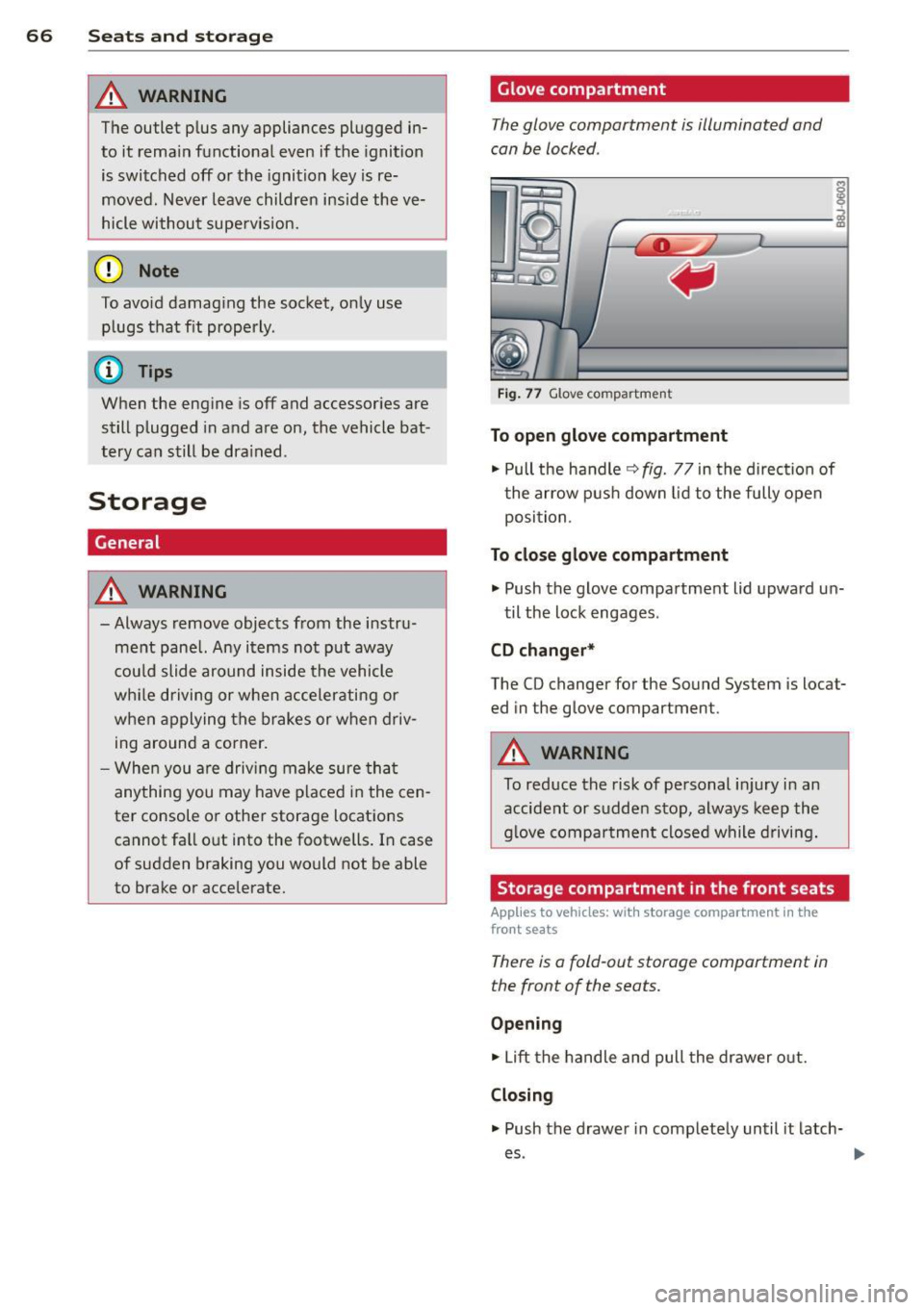
66 Seats and st o rage
A WARNING
The outlet p lus any appliances plugged in
to it rema in functional even if the ignition
is switched off or the ignition key is re
moved. N ever leave children inside the ve
hicle withou t supe rvision.
@ Note
To avo id damag ing the socket, only use
plugs that fit properly .
(i) Tips
When the engine is off and accessor ies are
still plugged in and are on, the vehicle bat
tery can still be dra ined .
Storage
General
A WARNING
- Always remove objects from the instru
ment panel. Any items not put away
cou ld slide around inside the vehicle
wh ile driving or when accelerating or
when applying the brakes or when driv ing around a corner.
- When you are drivi ng make sure tha t
anything you may have placed in the cen
ter console or other storage locations cannot fa ll out into the footwells. In case
of sudden braking you would not be able
to brake or accelerate.
-
Glove compartment
The glove compartment is illuminated and
can be locked .
§
___ .;.;._ _______ i
Fig . 77 G love compartme nt
To open glove compartment
• Pull the handle~ fig. 77 in the direct ion of
t he ar row push down lid to the fully open
position .
To close gl ove compartment
• Push the glove compartment lid upward un-
til the lock engages .
CD changer *
The CD changer for the Sound System is locat
ed in the glove compartment.
A WARNING
-To reduce the risk of personal i njury in an
accident or sudden stop, always keep the
g love compartment closed while driving.
Storage compartment in the front seats
Applies to vehicles: w ith storage compartment in the
front seats
There is a fold-out storage compartment in
the front of the seats.
Op ening
• Lift the handle and pull the drawer o ut.
Clo sin g
-
.. Push the drawer in completely until it latch
es .
Page 69 of 244
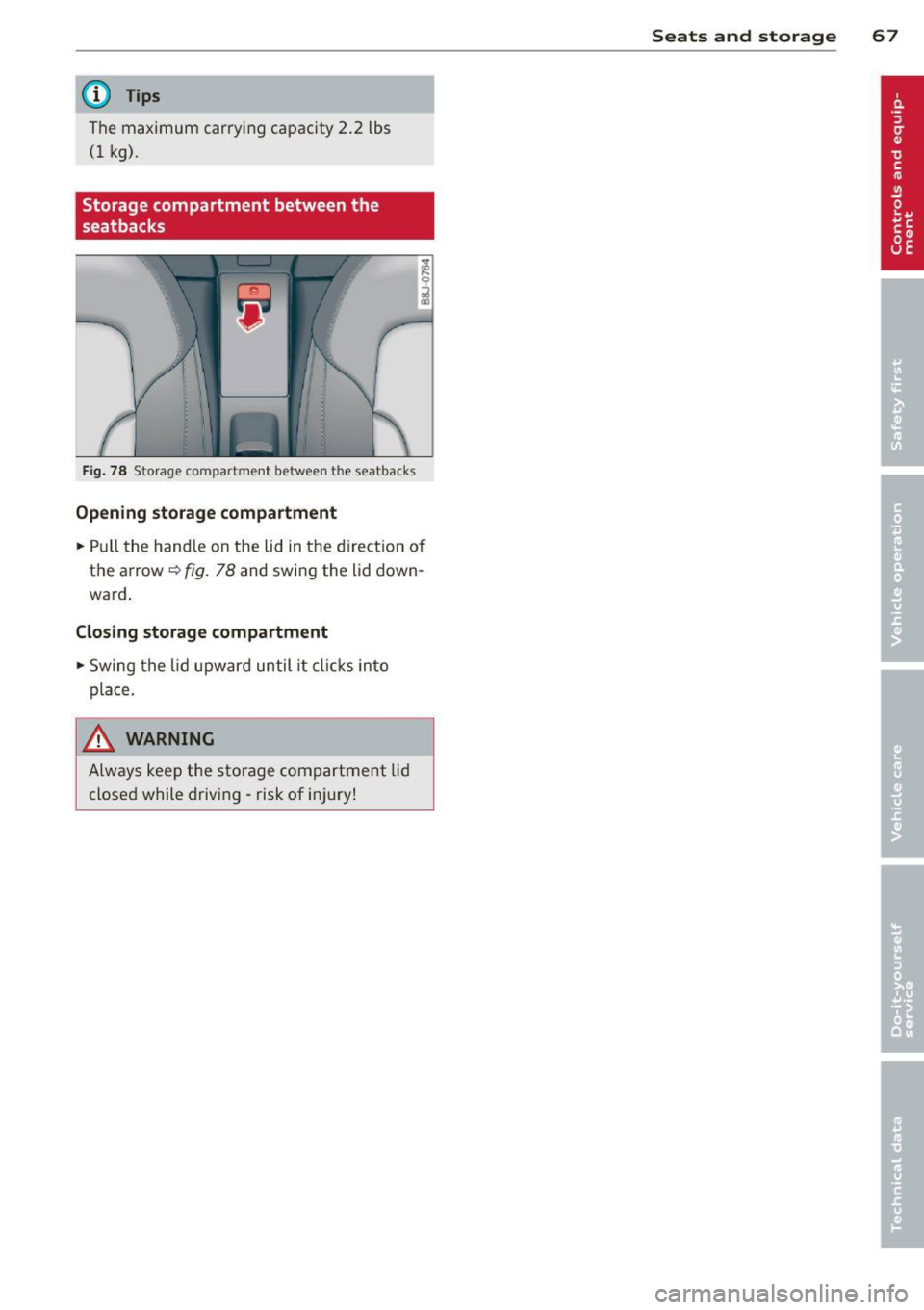
@ Tips
The maximum car ryi ng capac ity 2.2 lbs
(1 kg).
Storage compartment between the
seatbacks
F ig. 78 Storage compartment between the seatbacks
Opening storage compartment
.. Pull the hand le on the lid in the directio n of
t h e arrow~
fig. 78 and swing the lid down
ward .
Closing storage compartment
.. Swing the lid upward until it clicks i nto
pla ce.
A WARNING
Always kee p the sto rage compartment lid
closed while d rivi ng -risk of i njur y!
Seats and storage 67
Page 70 of 244
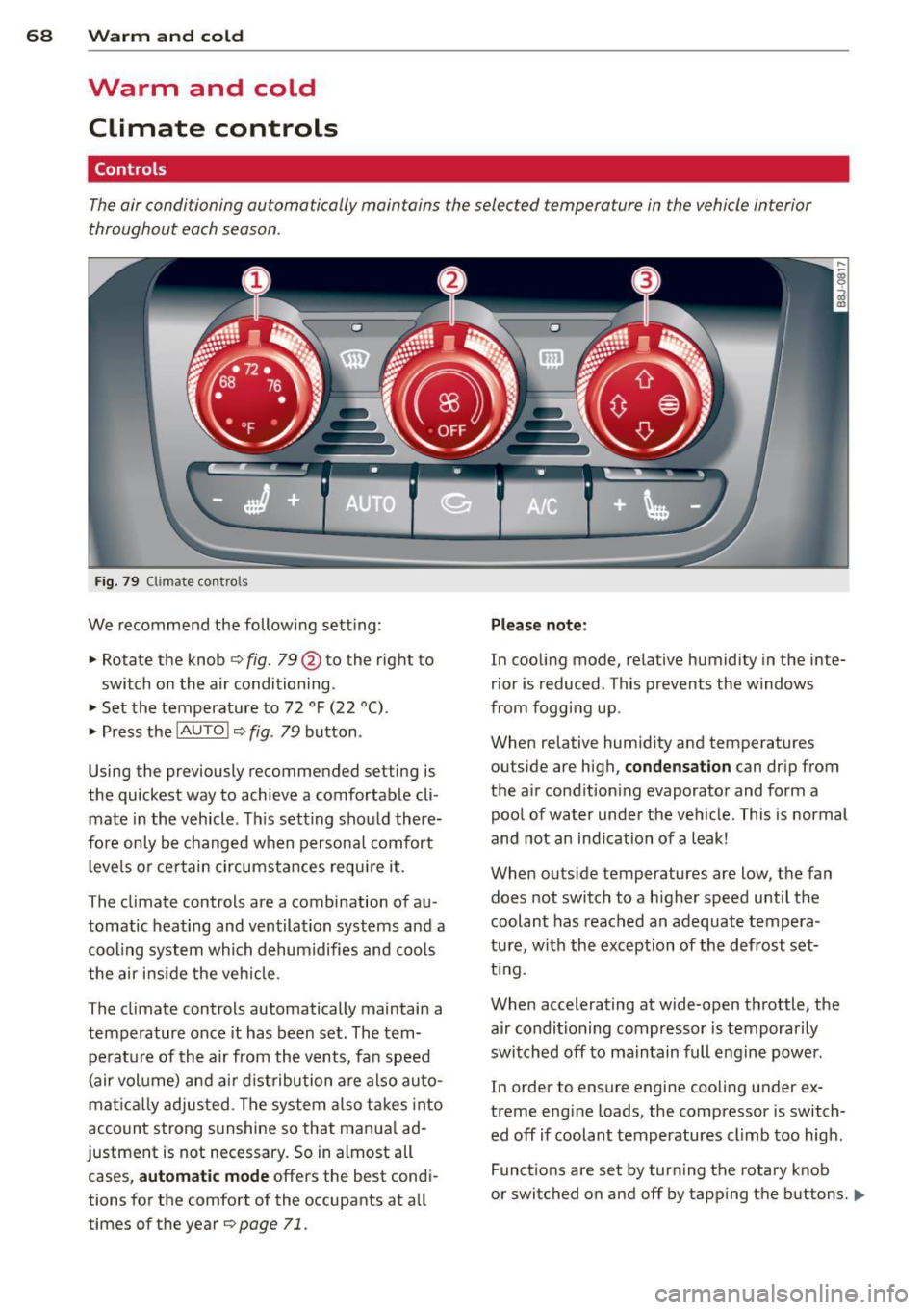
68 Warm and cold
Warm and cold
Climate controls
Controls
The air conditioning automatically maintains the selected temperature in the vehicle interior
throughout each season .
Fig. 79 Climate contro ls
We recommend the following sett ing :
> Rotate the knob 9 fig. 79 @ to the right to
switch on the air conditioning .
> Set the temperature to 72 °F (22 °().
> Press the !AUTO !~ fig. 79 button .
Using the previously recommended setting is
the quickest way to achieve a comfortable cli
mate in the vehicle . This setting should there
fore only be changed when personal comfort
l eve ls or certain circumstances require it.
The climate controls are a combination of au
tomatic heating and ventilation systems and a
coo ling system which dehum idifies and coo ls
the air inside the vehicle.
The climate controls automatically maintain a temperature once it has been set. The tem
perat ure of the air from the vents, fan speed
(air vol ume) and air distribution are also auto
matically adjusted . The system also takes into
account strong sunshine so that manua l ad
justment is not necessary. So in almost all
cases,
automatic mode offers the best condi
tions for the comfort of the occupants at all
times of the year
9 page 71 .
Please note :
In cooling mode , relative humidity in the inte
rior is reduced . This prevents the windows
from fogg ing up.
When relative humidity and temperatures outside are high ,
condensation can drip from
the a ir condition ing evaporator and form a
pool of water under the vehicle. This is normal
and not an ind ication of a leak!
When outside temperatures are low, the fan
does not switch to a higher speed until the
coolant has reached an adequate tempera
tu re, with the exception of the defrost set
t in g.
When accelerating at wide-open throttle, the air conditioning compressor is temporarily
switched off to maintain full engine power.
In order to ensure engine cooling under ex
treme engine loads, the compressor is switch
ed off if coolant temperatures climb too high.
Functions are set by turning the rotary knob
or switched on and off by tapp ing the buttons.
II>